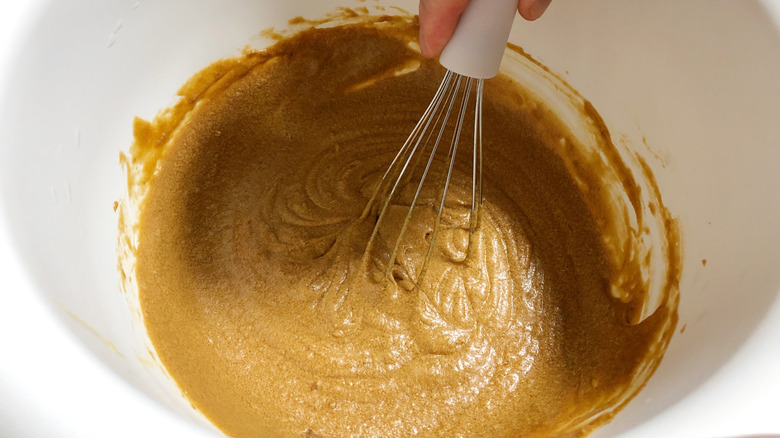The 2 Biggest Mistakes To Avoid For Perfect Pumpkin Bread
We may receive a commission on purchases made from links.
To ensure you get the most flavorful bite and a moist fluffy texture, we've got plenty of tips for baking the perfect pumpkin bread. An abundance of spices and a blend of different types of flour, nuts, and chocolate chips are among some of the additions that will lead to a better pumpkin bread.
But, what about fatal mistakes that can sabotage the successful results you seek? We've consulted Jessie-Sierra Ross, a former ballerina turned cooking and home entertaining author of "Seasons Around the Table; Effortless Entertaining with Floral Tablescapes & Seasonal Recipes" for her expert advice on what could go wrong during preparation and baking. "Pumpkin bread falls into the "quick bread" category of baked goods; meaning these types of recipes use baking powder or baking soda instead of yeast to get their lift. Similar to all quick bread recipes, there are two key mistakes that are often made when baking pumpkin bread," she said.
Jessie-Sierra added that the two biggest mistakes to avoid for perfect pumpkin bread are overmixing and overbaking. She also expanded on the perils of each mistake and the best practices to prevent them.
Avoid over-mixing your batter
Overmixing is a mistake that has harmful consequences for the texture of many quick-rising baked goods, including cake, brownies, and pancakes. However, each batter has its limits, and pumpkin bread's overmixing threshold is amongst the lowest. So keep those electric mixers, blenders, and hand emulsifiers in the cupboard and stick with a rubber spatula or a wooden spoon.
According to Jessie-Sierra, overmixing pumpkin batter makes the bread texture tougher than it should be. "We want to stir the wet and dry ingredients until they just barely come together, instead of overmixing into a homogenous batter like a cake," she explained.
Pumpkin bread uses wheat flour with gluten, a component that dictates the structure of any baked good with flour. Mixing batter agitates the gluten, causing it to form strands that help trap air bubbles. More prominently, though, this creates strong, chewy, elastic bonds. While this benefits yeasty bread like freshly baked sourdough or ciabatta, gluten development in quick bread will result in a gummy, dense texture. Gentle folding and minimal stirring are the movements you want for a perfectly mixed pumpkin bread batter.
Overbaking can ruin your pumpkin bread
Even if you manage not to overmix your pumpkin bread batter, letting it bake for too long in the oven will result in a crunchy, dried-out brick. All the moisture that pumpkin puree brings to the batter will evaporate out of the bread in a matter of minutes. Jessie-Sierra's advice is to be preemptively cautious.
"This [overbaking] leads to a dry, crumbly baked good," Jessie-Sierra suggested. "Check your pumpkin bread about five minutes before the recommended baking time by sinking a toothpick into the center of the bread. If it comes out clean (without dough sticking to it), your quick bread is done. If it's still wet, allow the bread to bake another five or so minutes and check again."
If you overbake your pumpkin bread, you can add moisture retroactively to a dry loaf. Use a spray bottle to mist slices before toasting them or wrap the loaf in tin foil and warm in a 300-degree oven. Another way to introduce moisture is through garnishes like icings or glazes. Try spreading this classic cream cheese frosting over your pumpkin bread or drizzling a warm cinnamon and brown sugar glaze over it.
Adding a bit more moisture to your pumpkin bread batter to safeguard against drying out in the oven is another option. Ingredients with high water content like shredded carrots and zucchini are a good start. You can also make our recipe for pumpkin banana bread, with the combined moisture from the mashed bananas and pumpkin puree.


